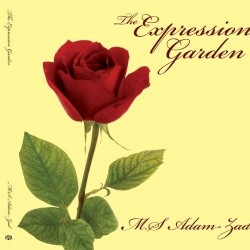The Expression Garden
Afghan poet M. S. Adam-Zad’s The Expression Garden embraces a series of poetic clichés—rainbows, love poems, and flowers. Certainly, poets have made these topics new in any number of ways, but that is not the case in Adam-Zad’s collection. The book’s layout betrays its tendency towards cliché even before the words are read.
The poet writes several pieces about the immorality and racism in the world, and chides people for their hypocritical intolerance of other religions. A large portion of the book centers on love and relationships while the final section spends time on religion and the author’s dreams of jinn (“to hide” or “be hidden” in Arabic).
In reading the poems, one finds that the gist of the work is often clear, but the actual rendition of precise images is confusing. Adam-Zad forces rhyme which leads to awkward or inexplicable word choices. Here, the use of “expert” and “avert” obscure meaning. Additionally, there are issues with grammar and syntax:
Heart pains, loss of youth, we useless expert.
Male dominate society, do you feel my hurt?
Message for everybody, avoid life from avert.
You supposed to be my husband, not a flirt?
The author does try to explore formal poetry, using a form that is reminiscent of a villanelle. It begins with two two-line stanzas and a single end rhyme scheme. The second line of the first and second stanzas repeats as the last lines of the third and fourth stanzas respectively. The scheme continues, then ends with the second line of the first stanza again. It is an interesting form where meaning accrues with repetition, and it certainly has potential for the author, but, again, syntax and trite images tend to get in the way.
Formatting and design issues significantly detract from the book’s content. The cover features a single red rose and the title in cursive lettering. Inside, each page has a rainbow arcing across its top and shadowy grass moving along its bottom. The dark colors of the rainbow make the text difficult to read, and the overall design seems much better suited to a children’s book. It also creates a very awkward tension between the themes of the collection, which include betrayal, divorce, ignorance, hatred, and intolerance. The text lacks a consistent top margin, causing the eye to wander as it looks for the start of the poem, and the titles are underlined, creating even more clutter on an already busy layout. Finally, some of the titles contain periods, and random end lines suddenly change font or appear in a larger size.
While this particular volume resists a particular audience, The Expression Garden may give people some insight into an Afghanistan woman’s views on religion, but even that is obscured by translation issues. Formalists may find the poet’s choices interesting and replicable.
Reviewed by
Camille-Yvette Welsch
Disclosure: This article is not an endorsement, but a review. The publisher of this book provided free copies of the book and paid a small fee to have their book reviewed by a professional reviewer. Foreword Reviews and Clarion Reviews make no guarantee that the publisher will receive a positive review. Foreword Magazine, Inc. is disclosing this in accordance with the Federal Trade Commission’s 16 CFR, Part 255.

